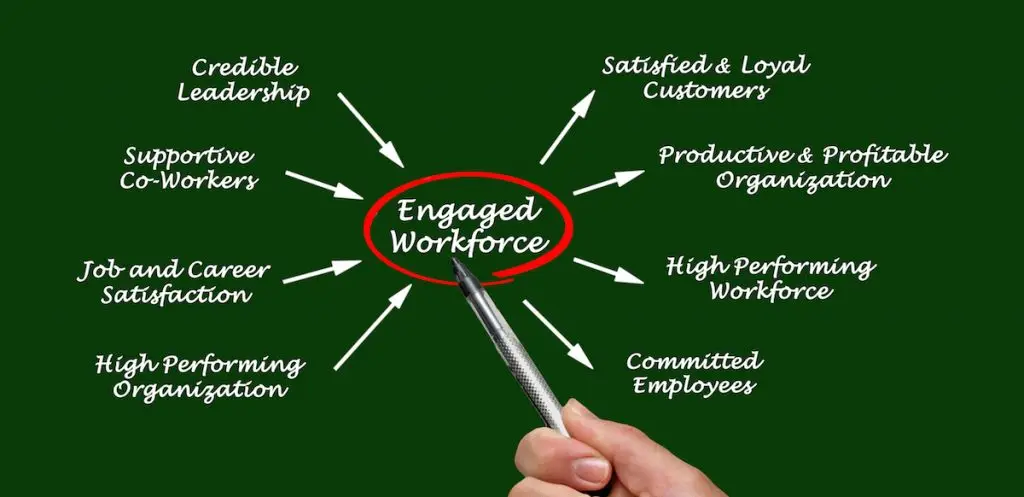It’s the middle of a workday—do you know if your team members are engaged?
According to the Gallup organization’s State of the American Workplace: 2010-2012 report, “70% of U.S. workers are not engaged at work.” Engagement is not the same as being happy or satisfied at work, although it is related. Engagement really gets into whether employees have well-defined roles, make strong contributions to the team, and feel connected to the larger organization (1). In other words, it’s directly related to the value you get from your team members and immeasurably important to your bottom line.
The Gallup report also mentions specific measurements that are positively affected by team engagement such as higher productivity, lower absenteeism, happier customers, higher quality, lower turnover … the list goes on … and every item contributes to a more successful company—and a more enjoyable workplace.
Here are five ways to improve your team’s engagement.
#1. Start off strong.
Challenge new team members from Day 1 … okay, maybe Day 2. I’m not suggesting you give them more than they can handle. There is a big difference between throwing someone to the wolves and helping them to contribute quickly. It’s important to give them the tools they need to succeed, but try to find a project that is likely to be a quick win.
Also, assign to them a mentor or advisor to introduce them to people and answer any questions. Ideally someone at their same level within the company so they feel comfortable asking any questions. The larger the company, the more important it becomes to network across the company—rather than just in the new employee’s department. Without an assigned “buddy,” meeting the right people can be very difficult, which can make it take longer for new employees to feel involved. Also, both everyday and critical information like where to get a parking pass can be easily overlooked.
If your employees start off on the right foot, feeling welcomed and important to the team, they’ll be that much more likely to engage as time goes on.
#2. Create common goals.
Encourage cross-functional team collaboration towards a unified goal. When people stick to their functions and work in silos, the lack of communication can not only lead to confusion and missteps, it can also create tension and disengagement. Fostering an environment in which people are encouraged to work across functions can lead to more creativity, motivation, and ultimately better results. Plus, empowered employees thrive on cross-functional teams.
#3. Communicate clearly and often.
To stay engaged on a task or project, people need to know why they’re doing what they’re doing. How does each person individually contribute to the overall objectives of the team and the company? If you’re not sure or don’t have a clear answer, taking time to figure out the answers can also really help clarify roles and responsibilities. Once you’re clear on the answers, make sure to communicate them effectively and frequently using multiple means. Reminding a team member how they’re contributing will not only keep them engaged, it’s also a great way to show appreciation and awareness of each person’s value. When people feel needed and valued, you’re pretty much guaranteed to have an engaged team.
#4. Provide unscheduled feedback.
Okay, I know this is old news: people need feedback. But it’s worth a reminder. You want to have built-in feedback, such as regularly scheduled reviews, but also feedback that’s given in less structured circumstances. Unexpected feedback can be that much more valuable. Perhaps you can find one way each day to show genuine appreciation to one person, or encourage your team managers to do the same. Also keep in mind that sometimes our best employees fly under the radar because they do their jobs well and don’t need help often. Be careful of expecting your best to do their best and forgetting to show gratitude. To keep them engaged, they need to feel needed and valued just like everyone else.
Also, this is another old story worth repeating: celebrate wins! Don’t be afraid to spend money on employee recognition and end-of-project celebrations. A $25-100 gift card to each team member goes a long way. It will have a big return on investment, whether you can quantify it or not. And your employees deserve it.
#5. Treat everyone fairly.
I think this is one of the hardest and most often overlooked components to team engagement. Our motivation is impacted by making comparisons to others—we can’t help it. If I am doing my job well and the guy next to me is slacking, and he never gets reprimanded or paid less or sees any consequence from underperforming, I am going to start underperforming. Either purposefully or because I’m frustrated and disengaged due to lack of appreciation for my work.
You must hold people in similar roles to similar standards and address performance issues in a timely manner. By the time you notice it, the other team members are already well aware, so you have to act fast. You owe it to your good employees to address any problems. Anything less is disrespectful to their hard work.
Some old ideas, and some new, but all helpful ways to keep your team engaged. If you read through them all you may notice the common theme of respect. Respect your employees and become intimately aware of their value, and you will naturally want to take these steps to show them your gratitude.
There are many additional ways to keep your teams engaged. Let me know some of the innovative ways you use in the comments below.
References:
(1) liquidplanner.com
[share title=”Share this Post” facebook=”true” twitter=”true” google_plus=”true” linkedin=”true” pinterest=”true” reddit=”true” email=”true”]





